Abstract
Fine roots play an important role in the overall functions of individual plants. Previous studies showed that fertilization and available soil resources have a notably profound effect on fine root, but there is lack of study centered on how fine root morphology, physiology, and chemistry respond to biochar with N additions. Different levels of biochar (0, 10, 15, and 20 g) and N (0, 2, 4 and 6 g) were applied to Acer mono seedling plants in a field nursery. The root system morphology and root chemistry and physiology were evaluated in line with root length, root diameter, SRL, N and N: C and root respiration. Biochar and N significantly affected root morphology, chemistry and root respiration. Morphological, chemical and physiological parameters were found to be at their maximum with 20 g biochar and 6 g N; however, no significant effect was noted on fourth- and fifth-order roots. Furthermore, a significant increase in root respiration was recognized with the increase in root tissue N concentration and the negative relationship of root respiration with higher branch order. Thus, overall, study parameters indicate that biochar and nitrogen positively influence the Acer mono fine root, and therefore should be used to improve fine root health.
Introduction
Nursery practices such as sowing, seedbed density, pruning, and fertilisation are usually standardised for individual plant species in order to produce high-quality seedlings1. Different fertilisers and nutrients are widely used to improve plant vigour and productivity2. Fine roots play a vital role in root systems since they show high physiological activity during nutrient and water uptake from soil3. These fine roots respond rapidly to changes in the environment. This characteristic of fine roots enables them to be used as an indicator for plant physiological status during environmental changes such as acidification or drought4. The response patterns of fine roots for environmental changes are usually in the form of changes in biomass5, morphological changes such as root diameter and specific root length6, and chemistry such as nitrogen concentration4. Fine root morphology is significant as it is critical to many functions including nutrient absorption.
The characteristics of root morphology such as root surface area, root length, and root radius determines a plant’s ability to compete for soil nutrients. Sattelmacher et al.7 reported that underground resources can be best harvested by a plant through increased root length or root surface area. In addition, N fertilisation significantly increased root tip morphology of Pongamia pinnata seedlings8. Thus, fine-root morphology shows how the plant root responds to different nutrient levels.
Nitrogen fertilisation influences root chemistry and morphology3. Root length and root surface area increase under intermediate levels of N fertilisation9. A study by Pregitzer et al.10 showed that when N is abundantly available in soil, it results in increased N concentration in roots followed by an increased rate of respiration. It has been suggested that fine root respiration facilitates carbon cycling in forests, hence, aiding the response by vegetation to global environmental changes11, 12. According to the published studies, root growth is triggered and maintained by root respiration, which further enhances ion absorption and transportation through the plant, especially in the xylem13, representing the physiological metabolic capacity of the roots14. Root respiration is an intricate process that encompasses both physiological and ecological mechanisms that in turn are intimately connected with root structure15.
Fine roots are varyingly defined as having diameters of <2 mm or <1 mm11, and have unique physiological functions10, 15. It has been shown that root respiration rates of various species and biomes are highly influenced by root N concentration, soil N availability, and temperature16. Guo et al.3 predicted that the higher rates of respiration can be found in first-order (i.e. finest) roots which usually have shorter a life span since their tissues contain high concentrations of nitrogen. In the present study, we combined biochar with nitrogen fertilisation to determine the effects on root growth, because although previous studies have showed positive effects of biochar on root morphology17, there are currently no detailed studies on the physiological and chemical changes in fine roots, or on the effect of biochar and N fertilization combined.
Nurseries use biochar to improve soil properties, especially fertility18. Biochar has physicochemical properties highly beneficial to plants, such as high porosity, high capacity for cation exchange which enhances nutrient retention, increased presence of beneficial microorganisms, and high water retention capacity19. A further study describes the benefits brought about by biochar application such as soil fertility improvement, enhanced plant growth, increased soil carbon sequestration, and reduced gas emissions20.
Studies have found a significant increase in root tip number (64%) and root biomass (47%) in (Larix gmelinii)21, increased root length in Asian rice (Oryza sativa)22, and increased lateral root length in edible asparagus, within the layer of applied biochar17. Therefore, it is logical to conclude that the presence of biochar leads to abundant root growth and significant positive changes in root behaviour. Van Zwieten et al.23 showed that the application of biochar on its own will only slightly increase plant growth, but it has also been shown that the combined application of biochar and nitrogen fertiliser increases plant growth, biomass, and yield24. Chemical fertilisers, zeolite, wood vinegar, and organic fertilisers are added to wood charcoal to increase its beneficial effects in tea plants, citrus, and vegetables25.
Studies have also shown promising effects on growth and plant production by combining biochar with mineral fertilisers23, 26. In the current study, we examined the root traits of Acer mono across five root orders. Specifically targeted root traits included root morphology (total root length, average root diameter, and specific root length), chemistry (tissue N concentration and C:N ratio), and physiology. We aimed to address two questions: how fine root orders vary with biochar and nitrogen addition, and how the physiological and metabolic functions vary with biochar and nitrogen addition across five root orders.
Results
Effect of biochar and N applications and their interaction on root morphology
Biochar application significantly (p < 0.05) increased total root length (TRL), average root diameter (ARD), and specific root length (SRL) values (Figs 1a–c, 2a–c and 3a–c), of first, second, and third root orders compared with untreated seedlings (control). The values of these three parameters were the highest with 20 g biochar per seedling. Similarly, N fertilisation significantly (p < 0.05) increased the root morphological index values (i.e. TRL, ARD, and SRL) of first, second, and third root orders, and the values of these parameters were highest in the seedling treated with 6 g N fertilisation (Figs 1a–c, 2a–c and 3a–c). Furthermore, biochar and N alone had no significant effect on fourth- and fifth-order roots.
Figure 1.
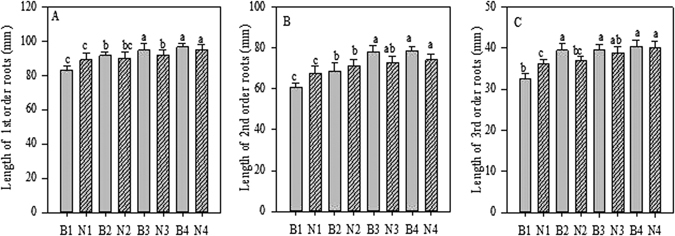
Root Length of first-third order roots after Biochar and Nitrogen addition. B stands for Biochar levels (B1-B4); N stands for Nitrogen levels (N1-N4). Different letter show the level of significance. Error bars represent the standard error of the mean.
Figure 2.
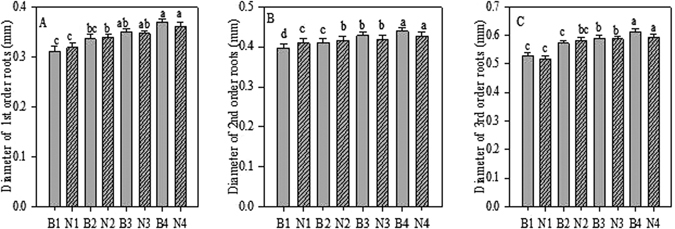
Root Diameter of first-third order roots after Biochar and Nitrogen addition. B stands for Biochar levels (B1-B4); N stands for Nitrogen levels (N1-N4). Different letter show the level of significance. Error bars represent the standard error of the mean.
Figure 3.
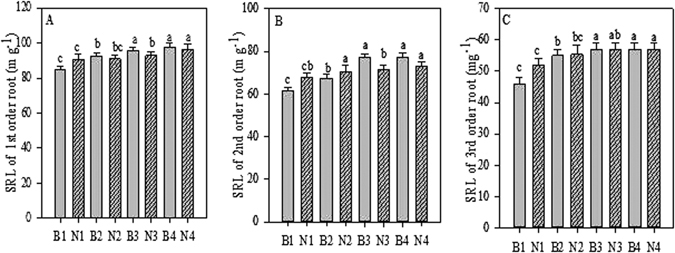
SRL of first-fifth order roots after Biochar and Nitrogen addition. B stands for Biochar levels (B1-B4); N stands for Nitrogen levels (N1-N4); SRL stand for specific root length. Different letter show the level of significance. Error bars represent the standard error of the mean.
We also observed a significant (p < 0.05) positive effect of biochar and N for TRL and SRL of first- and second-order roots, but found that interaction significant for ARD of first, second, and also third root orders. The TRL and SRL values of the first two orders, as well as the ARD values of first- to third-order roots, were highest in seedlings treated with 20 g biochar and 6 g N combined (Tables S1–S3). We observed no significant (p < 0.05) effect on TRL and SRL values of third, fourth, and fifth orders, nor for ARD values of fourth- and fifth-root orders (Tables S1–S3).
Effect of biochar and N applications and their interaction on root chemistry
Fine roots of the first five root orders treated with biochar showed significantly (p < 0.05) increased root-tissue N concentration and C:N ratios compared to those of control (Figs 4a–e and 5a–e). In all five root orders, the values were the highestin seedlings treated with 20 g biochar each. Similarly, N fertilisation significantly (p < 0.05) increased root-tissue N concentration and C:N ratio in the fine roots of the first five root orders. In all five root orders, the values were the highest in seedlings treated with 6 g N fertiliser (Figs 4a–e and 5a–e). In combination, the highest increase in root-tissue N concentration and C:N ratio in the first five root orders of the seedlings were observed when treated with 20 g biochar and 6 g N per seedling (Tables S4 and S5).
Figure 4.
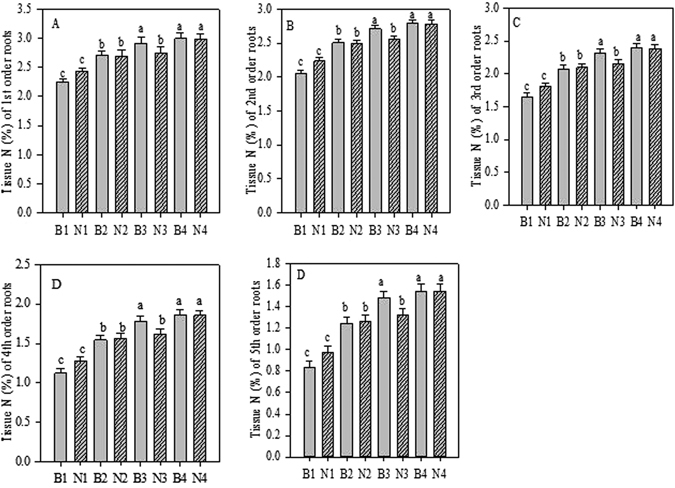
Root tissue N concentration of first-fifth order roots after Biochar and Nitrogen addition. B stands for Biochar levels (B1-B4); N stands for Nitrogen levels (N1-N4). Different letter show the level of significance. Error bars represent the standard error of the mean.
Figure 5.
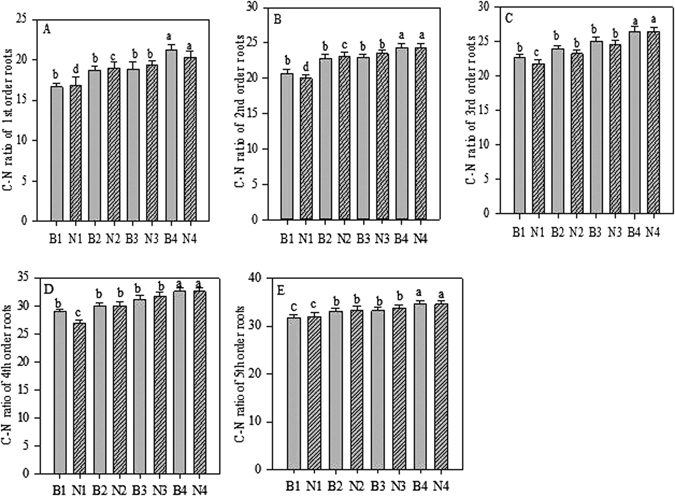
Root C- N ratio of first-fifth order roots after Biochar and Nitrogen addition. B stands for Biochar levels (B1-B4); N stands for Nitrogen levels (N1-N4). Different letter show the level of significance. Error bars represent the standard error of the mean.
Effect of biochar and N applications and their interaction on root respiration
Seedlings treated with biochar significantly (p < 0.05) increased root respiration for first- to fifth-order roots (Fig. 6a–e). Respiration rate increased from first to fifth order with increasing biochar levels, and the highest rates were recorded in seedlings treated with 20 g biochar each. Similarly, N levels significantly (p < 0.05) increased root respiration rates in each order roots, and the highest values were recorded in seedlings treated with 6 g N (Fig. 6a–e). We also observed a significant (p < 0.05) interaction effect of biochar and N on root respiration in each order, with the highest values being recorded in seedlings treated with 20 g biochar and 6 g N (Table S6).
Figure 6.

Root respiration of first-fifth order roots after Biochar and Nitrogen addition. B stands for Biochar levels (B1-B4); N stands for Nitrogen levels (N1-N4). Different letter show the level of significance. Error bars represent the standard error of the mean.
When analysed, the correlation between root respiration and tissue N concentration showed a close relationship between fine root respiration rate and root N concentration where R 2 was 0.7922 and p values were less than 0.001 (Fig. 7).
Figure 7.
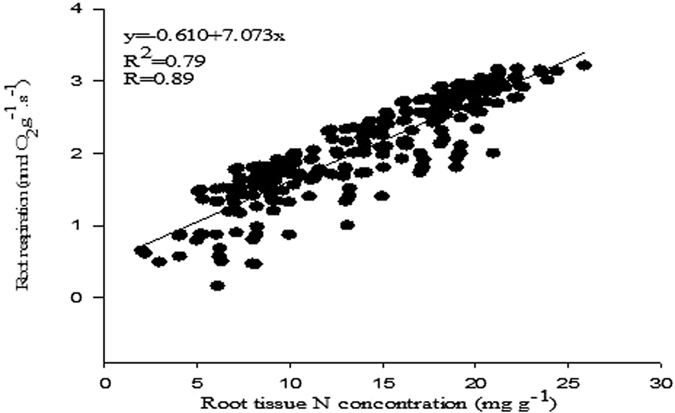
Relationship of root respiration rate and root N concentration in Acer mono. Data for each of three replicates, 16 treatments, and five root orders are included in the plots.
Discussion
Effect of biochar and N applications and their interaction on root morphology
Many studies have reported that biochar increases plant crop growth and yield24 in natural woodland as well as in cultivated fields27, 28. Noguera et al.22 stated that biochar application increased not only root growth but also shoot-to-root biomass ratio. Guo et al.29 reported that biochar has long been known to increase root volume, length, and surface area of Poncirus trifoliata (L.) Raf. seedlings in Gannan acidic red soil. Our results also showed that biochar application improved root morphology (i.e. TRL, ARD, and SRL) of A. mono seedlings (Figs 1a–c, 2a–c and 3a–c).
The current study findings are in agreement with the results of Yang et al.30, who concluded that during the seedling stage in a sugarcane cultivar, applying biochar improves root morphology. When bark charcoal is applied, they found that the root amount number (or biomass) significantly increased along with the increase in maize arbuscular mycorrhizal (AM) fungi colonisation rate. Ishii and Kadoya31 further reported that when charcoal is applied, there is an increase in root growth. Fine root morphological changes are associated with changes in soil water retention32 and evaporation33, and when these enhancements in the soil’s physical and chemical properties occur, they have a profound effect on root growth. Contrary to our results however, Deenik et al.34 found a decrease in plant growth in similar conditions following biochar application.
Biochar added to the soil forms organomineral complexes, so increasing the nutrient status and availability of the soil; it also improves microbial community composition, boosts systemic plant defences, and reduces soil pathogen load, which subsequently improve the health of plant with minimum harm to the environment35. Overall, these results demonstrate the potential of biochar application for improving plant growth efficiency.
When nitrogen is supplied at a plant’s seedling stage, it results in rapid growth, and when introduced after this period of rapid growth, plants obtain the ability to absorb and fix N at a higher rate. Williams and Haynes36 noted that the requirement for nitrogen is limited during the seedling stage but it increases hugely during subsequent growth. In most instances, the amount of nitrogen in the soil is a limiting factor on the plant’s growth, hence the need for fertiliser remains in order to support and sustain maximum growth. In the present study, there is a close relationship between nitrogen concentrations and root growth.
This relationship has been widely reported for annual crops37 and perennial plants38. Longer root lengths and greater root surface areas are obtained with medium N fertiliser concentrations, compared with either no N fertiliser or higher concentrations of fertiliser9. Fine root elongation significantly increases with N application39, 40. By contrast, N fertilisation tends to decrease fine root proliferation41. The above studies also conclude that the fine root response to N fertilisation is affected by soil fertility and other soil chemical conditions. Furthermore, the scale of the study area has an impact on the pattern of changes in fine root elongation. For instance, when microsites are provided with N fertilisation, the proliferation of fine roots results42.
In the current study, the plants in the N-fertilised plots showed higher root length and root diameter of fine roots compared to the control plots. These values were significantly higher in the first three order roots (Figs 1a–c and 2a–c). These results are in line with the pattern of N fertilisation enhancing root length and root diameter demonstrated in a previous study9. Similar results were obtained by Noguchi et al.43, showing an increased rate of fine root elongation in N-fertilised plots compared to control plots. In our study, fine root morphology showed a clear relationship with nitrogen addition, in that the SRL was higher in the first three orders of root compared with control plants (Fig. 3a–c). This builds on the findings of a previous study that showed that the SRL of fine roots varies with soil N concentration39.
When N fertilisers are used, the fine root SRL usually decreases6. Specifically, a study by Wang et al.44 reported that the SRL of first- and second-order roots of Pinus tabuliformis are decreased by N fertilisation. Ironically, under heterogeneous soil nutrient conditions, root proliferation usually happens in nutrient-rich patches10. Furthermore, biochar and nitrogen together significantly affected overall parameters of fine root morphology of first- and second-order roots (Tables S1–S3). Surface root length values have an important role as an index to measure the cost and benefit of fine roots to the plant, as it is assumed that the root length is proportional to the acquisition of resources, whereas the root mass is proportional to growth and maintenance45.
Biochar and nitrogen therefore significantly increase root proliferation of first- and second-order roots. Furthermore, SRL is positively linked with N uptake and root respiration46. The results of the current study showing increased fine root SRL may be because A. mono plants responded rapidly to the additions, so increasing the soil resource acquisition from N-rich patches. As mentioned in the literature47, SRL may be affected by physical properties of the soil such as porosity and bulk density. We observed that the soil’s physical and chemical characteristics did indeed affect the morphological responses of fine roots to N fertilisation.
Effect of biochar and N applications and their interaction on root chemistry
Biochar significantly increases uptake of N in plants, as reported by Zwieten et al.23. According to a study by Chan et al.48, when treated with biochar, radish plants (Raphanus raphanistrum subsp. sativus) show a higher N uptake. This increase in uptake of N indicates the potential of biochar to improve fertiliser use efficiency in soil. Many studies49–52 have shown the benefits of biochar application for promoting plant development, i.e. increased above-ground biomass, higher overall growth, improved soil water-retention capacity, higher net assimilation rates, increased total content of N, P, K, Mg, Cu, and Zn leading to an increase in fine root proliferation through enhanced SRL and reduced root tissue density, and increased yield through improving the physical and biochemical properties of cultivated soils.
Our results revealed that biochar significantly increased root-tissue N concentration and C:N ratio in each order of root (Figs 4a–e and 5a–e). These increases in root tissue parameters demonstrate a positive interaction between biochar particles and roots. Salim53 found a significant increase in N concentration in common wheat root and leaf tissues when using biochar. Ironically, peanut (Arachis hypogaea L.) hull biochar showed an increase in soil N concentration with no effect on maize tissue N, when applied at 11.2 and 22.4 mg/ha49. A study on geographical conditions focusing on loamy sand in Georgia, US, showed no increase in soil N or tissue N when using pine (Pinus spp.) woodchip biochar54. According to Prendergast-Miller et al.55, while wheat root length is increased and root N uptake is decreased when biochar is used, there is no effect on plant biomass and plant N content.
Many studies10, 56 have shown that root N concentration decreases with increasing root order (Fig. 7a–e). Similarly, C:N decreases with increasing root order56. The C:N ratio increases as root order increases, and within each root order is highest with N treatment10 (Fig. 5a–e). Different species show differing responses to nitrogen fertilisation in terms of tissue N concentration. Pregitzer et al.10 reported an increase of N concentration in roots after N fertilisation in the first three root orders, but only in three out of nine temperate deciduous tree species. Likewise, there is a strong response shown by all five fine root orders toward N fertilisation, which is closely related to low soil N availability, and low baseline root-tissue N concentrations57.
The results of our study corroborated those of Sun et al.58, in that N fertilisation significantly increased N concentration in first- to fifth-order roots (Fig. 4a–e). The conflicting results of Pregitzer et al.10 couldbe explained through a possible relationship between baseline N concentration and root order responses to fertilisation. The lowest concentrations of soil N treatments did not alter the fine-root N concentrationsignificantly59, whereas the higher N treatments caused a significant increase in the total N, in fine root biomass, and in total plant biomass in deciduous treespecies60. Interestingly, in our study, we also found significant positive effects of biochar and N across all five root orders (Table S4). Pinustaeda fine roots have been shown to increase at elevated CO2, demonstrating the linear relationship described by the carbon-nutrient balance hypothesis61, 62.
Effect of biochar and N applications and their interaction on root respiration
In the current study, the roots of different branch orders were seen to exhibit distinct differences in their rates of respiration. Specifically, the relationship between root respiration and root branch order seems to be inversely proportional, i.e. first-order roots show the highest root respiration rate compared to all fourother root branch orders (Fig. 6a–e). Biochar has been reported to influence microbial composition and activity, which may in turn affect mineralisation/immobilisation processes in the soil2. A study by Zak et al.63 inferred that there is a significant increase in microbial biomass C around the rhizosphere and in the bulk soil region when plants are grown under elevated CO2 conditions.
In conditions where soil nutrients are abundant, morphology64, tissue N concentration and soil respiration65, and fine root biomass66 are all affected. The impact on root respiration in such conditions, however, varies according to different parameters including measurement methods, root diameter, soil nutrient condition, and time of fertilisation16. Generally, the addition of N fertilisers increases the rate of root respiration59. For instance, when seedlings of P. Taeda were fertilised, they showed increased root respiration67. Drake et al.16 reported that when free-air CO2 enrichment and N fertilisation are combined, a reduction of about 40% in fine root respiration results.
The current study showed that the rate of root respiration increased in the first five root orders and was highest with combined N fertilizer and biochar application compared to control (Table S4). The reason for increased root respiration with N fertilisation may be an increase in root-tissue N concentration11. A positive correlation exists between root-tissue N and the energy for protein turnover and ion exchange (i.e. maintenance respiration)68, whereas increased availability of nitrogen is related to enhanced metabolic activity per unit root mass11. As nitrogen concentration in root tissues increases when N is introduced as fertiliser, this ultimately results in increased root respiration. A further mechanism that helps to increase root respiration through N fertilisation is an increase in the efficiency of root N uptake66.
The process of respiration is connected with nitrogen concentration in tissues of different organs such as fine roots, leaves, and stems69. The current study showed that there was a high correlation between root-tissue N concentration and root respiration (Fig. 7), as concluded in a previous study11.
A study has shown that physiological activity is reflected in the root respiration rate70. In the current study, the increased respiration in first-order roots seems to be consistent with higher metabolic activity when compared with higher order roots. There is also a relationship between physiological functions, and branch age and order71; and nitrate uptake and root respiration both decline rapidly as root age increases72. Furthermore, the variation in root functions is manifested in tissue N concentrations. The positive correlation of respiration rate with N concentration in our study is consistent with the theory that maintenance respiration depends on an adequate tissue-protein concentration57.
Conclusion
Our results demonstrate that biochar and nitrogen strongly interact to influence A. mono fine-root morphology, chemistry, and respiration. The strongest effects on root traits and physiology are seen when both sufficient organic matter and N are available. Our study found a positive influence of biochar and nitrogen on root morphology in first- to third-order roots, and a significant positive effect on root chemistry across the five root orders. Moreover, the combination of biochar and N increased the tissue nitrogen concentration, which in turn has a linear relationship with root respiration, and hence increases the root respiration of the individual roots. Overall, our study reveals that a combination of biochar and nitrogen had a profound effect on root traits of A. mono. However, literature is scarce on the influence of biochar and N, especially on root traits, chemistry, and respiration, and therefore further studies are needed to explore the mechanisms and potential applications of these relationships.
Study site and soil collection
This experiment was conducted at the Maoershan experimental station for seedling growing (127°′‒127°′E, 45°23′‒45°26′ N, 390 m above sea level), which is located in the temperate forest region in Heilongjiang Province of Northeast China. The station has cold environmental conditions with continental monsoon climate where 2.8 °C remains to be the average air temperature on yearly basis whereas in January and July, the average temperatures are −19.6 °C and 20.9 °C, respectively. The annual average humidity, annual precipitation, and annual evaporation are 70%, 723.8 mm, and 1094 mm, respectively. And the soil is mostly dark-brown earth, which belongs to Boric Luvisols in the classification system of Chinese Soil Taxonomy73; the frost-free period usually lasts from 120 to 140 d.
Soil samples were collected from the experiment field at 0–20 cm soil depth and were thoroughly mixed to make a representative composite soil sample that had a total N, P, and K content of 3.98 g kg−1, 820.8 mg kg−1, and 14 g kg−1, respectively, and an available N, P, and K content of 4, 7.23, and 176 mg kg−1.
Plant materials and fertilization treatments
Four-year-old A. mono Maxim L. seedlings of uniform size were selected in a field nursery for study. Planting spacing was 20 cm × 30 cm. Each seedling was treated with one of four levels of biochar B1, B2, B3, B4 (0, 10, 15, or 20 g) and one of four levels of N1, N2, N3, N4 (0, 2, 4, or 6 g). Ten plants were included in each treatment, and each treatment was replicated three times (total n = 480). We applied nitrogen in two split doses during May and July, and biochar was applied once as a basal dose in May. Standard cultural practices were performed during the experiment (i.e., weeding, hoeing, irrigation, etc.), in order to produce healthy seedlings.
Root morphology measurement
Root samples were carefully taken in each treatment group during harvesting, using the procedure described by Guo et al.15. After harvesting, the root samples were shifted to the laboratory in an ice box within four hours. The individual samples were cleaned with de-ionized water to remove residual soil particles and stored in a refrigerator. As per Pregitzer et al.10 method, distal branch order as the first order, the root samples of each treatment were divided into different branch orders (Fig. 8). The samples separated as mentioned above were scanned with Expression 10000XL 1.0 scanner (dpi = 400; Epson Telford, Ltd., Telford, UK) following which the images were analyzed with the help of WinRHIZO (Pro2004b) software (Instruments Regent Co., Ville de Québec, QC, Canada) in order to measure the Average Root Diameter (ARD) and Total Root Length (TRL). Finally, the roots were oven dried to constant mass at 65 °C, in order to determine dry mass, and SRL was calculated as the TRL from each root order divided by the corresponding dry mass74.
Figure 8.
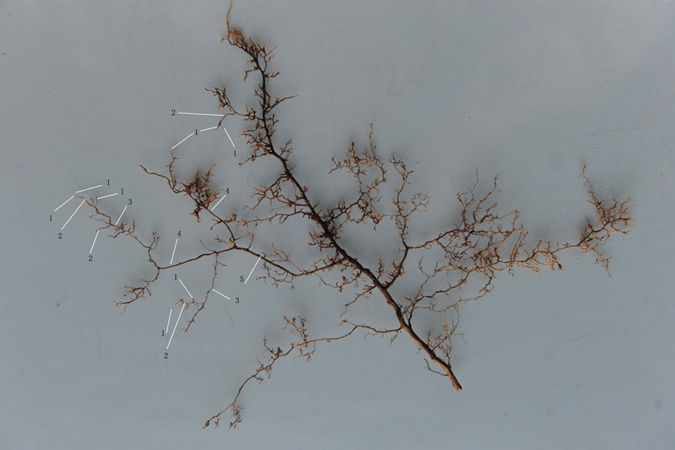
Acer mono root orders from first to fifth orders.
Root respiration and root tissue N concentration
In September 2016, fine roots were collected at random locations within each plot with the help of a specially constructed 20 × 20 cm rectangular soil corer that is equipped with sharpened edges root samples were hand-mixed and packed in the plastic bags and then transported to the laboratory for measuring root respiration. Every day, sampling was done twice at different time intervals (6:00 and 17:00 hours) whereas within four hours of collection, the samples were measured for root respiration. After washing with deionized water gently, each composite sample was used.
After cutting the living roots from branch nodes, all the five root branch orders are sorted with root tips designated as first-order roots as per the procedure by Pregitzer et al.10. 0.5 g of root samples were allowed to equilibrate in the water at respective measurement temperatures for 30 min which is then followed by monitoring O2 consumption for 30 more minutes using gas-phase O2 electrodes (Model LD 2/2, Hansatech Instruments Ltd, King’s Lynn, UK) connected to constant-temperature circulating water baths11. Post completion of respiration measurements, the root samples were oven-dried at 75 °C for 24 h and weighed. Root respiration was calculated as nmol O2 g−1 s−1 (dry weight). Once the drying and weighing is done, every treatment’s root samples and root order, its total N and C:N concentration were measured with the help of a Macro Elemental Analyzer (vario MACRO, Elementar Co., Germany).
Statistical analysis
The experiment was conducted in a randomised complete block design, with split-plot arrangements so that the effects of biochar, nitrogen fertiliser, and their interaction on seedlings, root morphology, root physiology, and chemistry could be tested. The data collected was analysed using two-way analysis of variance (ANOVA) with the software package SPSS 21.0 (IBM, Guildford, UK). LSD test was also performed for the experiments to compare treatments with one another. The correlations between total root N concentration and root respiration were performed using Sigma Plot 12.5 (Systat Software, San Jose, CA). Significance levels were set at 0.05.
Electronic supplementary material
Acknowledgements
This study was supported by the Fundamental Research Funds for the Central Universities (2572016AA40).
Author Contributions
Shen Hailong and Zhang Peng initiated and designed the research, M. Razaq, and Salahuddin, performed the experiments, Hassan sher analyzed the data and M. Razaq and Shen Hailong wrote the manuscript.
Competing Interests
The authors declare that they have no competing interests.
Footnotes
Electronic supplementary material
Supplementary information accompanies this paper at doi:10.1038/s41598-017-05721-2
Publisher's note: Springer Nature remains neutral with regard to jurisdictional claims in published maps and institutional affiliations.
References
- 1.Mexal JG, Rangel RAC, Negreros-Castillo P, Lezama CP. Nursery production practices affect survival and growth of tropical hardwoods in Quintana Roo, Mexico. Forest Ecology and Management. 2002;168:125–133. doi: 10.1016/S0378-1127(01)00735-6. [DOI] [Google Scholar]
- 2.Shen J-P, Zhang L-M, Guo J-F, Ray JL, He J-Z. Impact of long-term fertilization practices on the abundance and composition of soil bacterial communities in Northeast China. Applied Soil Ecology. 2010;46:119–124. doi: 10.1016/j.apsoil.2010.06.015. [DOI] [Google Scholar]
- 3.Guo DL, Mitchell RJ, Hendricks JJ. Fine root branch orders respond differentially to carbon source-sink manipulations in a longleaf pine forest. Oecologia. 2004;140:450–457. doi: 10.1007/s00442-004-1596-1. [DOI] [PubMed] [Google Scholar]
- 4.Hirano Y, Mizoguchi T, Brunner I. Root parameters of forest trees as sensitive indicators of acidifying pollutants: a review of research of Japanese forest trees. Journal of forest research. 2007;12:134–142. doi: 10.1007/s10310-006-0263-2. [DOI] [Google Scholar]
- 5.Finér L, Ohashi M, Noguchi K, Hirano Y. Fine root production and turnover in forest ecosystems in relation to stand and environmental characteristics. Forest Ecology and Management. 2011;262:2008–2023. doi: 10.1016/j.foreco.2011.08.042. [DOI] [Google Scholar]
- 6.Ostonen I, et al. Specific root length as an indicator of environmental change. Plant Biosystems. 2007;141:426–442. doi: 10.1080/11263500701626069. [DOI] [Google Scholar]
- 7.Sattelmacher, B., Klotz, F. & Marschner, H. In Genetic Aspects of Plant Mineral Nutrition 57–63 (Springer, 1990).
- 8.Mukta N, Sreevalli Y. Propagation techniques, evaluation and improvement of the biodiesel plant, Pongamia pinnata (L.) Pierre—a review. Industrial Crops and Products. 2010;31:1–12. doi: 10.1016/j.indcrop.2009.09.004. [DOI] [Google Scholar]
- 9.Costa C, et al. Root morphology of contrasting maize genotypes. Agronomy Journal. 2002;94:96–101. doi: 10.2134/agronj2002.0096. [DOI] [Google Scholar]
- 10.Pregitzer KS, et al. Fine root architecture of nine North American trees. Ecological Monographs. 2002;72:293–309. doi: 10.1890/0012-9615(2002)072[0293:FRAONN]2.0.CO;2. [DOI] [Google Scholar]
- 11.Burton A, Pregitzer K, Ruess R, Hendrick R, Allen M. Root respiration in North American forests: effects of nitrogen concentration and temperature across biomes. Oecologia. 2002;131:559–568. doi: 10.1007/s00442-002-0931-7. [DOI] [PubMed] [Google Scholar]
- 12.Atkin OK, Edwards EJ, Loveys BR. Response of root respiration to changes in temperature and its relevance to global warming. New Phytologist. 2000;147:141–154. doi: 10.1046/j.1469-8137.2000.00683.x. [DOI] [Google Scholar]
- 13.Lambers, H., Chapin Iii, F. S. & Pons, T. L. In plant physiological ecology 321–374 (Springer, 2008).
- 14.Wells CE, Eissenstat DM. Beyond the roots of young seedlings: the influence of age and order on fine root physiology. Journal of Plant Growth Regulation. 2002;21:324–334. doi: 10.1007/s00344-003-0011-1. [DOI] [Google Scholar]
- 15.Guo D, et al. Anatomical traits associated with absorption and mycorrhizal colonization are linked to root branch order in twenty†three Chinese temperate tree species. New Phytologist. 2008;180:673–683. doi: 10.1111/j.1469-8137.2008.02573.x. [DOI] [PubMed] [Google Scholar]
- 16.Drake JE, Stoy PC, Jackson RB, DeLucia E. Fine†root respiration in a loblolly pine (Pinus taeda L.) forest exposed to elevated CO2 and N fertilization. Plant, Cell & Environment. 2008;31:1663–1672. doi: 10.1111/j.1365-3040.2008.01869.x. [DOI] [PubMed] [Google Scholar]
- 17.Matsubara Y, Hasegawa N, Fukui H. Incidence of Fusarium root rot in asparagus seedlings infected with arbuscular mycorrhizal fungus as affected by several soil amendments. Journal of the Japanese Society for Horticultural Science. 2002;71:370–374. doi: 10.2503/jjshs.71.370. [DOI] [Google Scholar]
- 18.Ogawa, M. (Chikushishokan publishing, Tokyo (in Japanease), 2007).
- 19.Sohi SP, Krull E, Lopez-Capel E, Bol R. A review of biochar and its use and function in soil. Advances in agronomy. 2010;105:47–82. doi: 10.1016/S0065-2113(10)05002-9. [DOI] [Google Scholar]
- 20.Stavi I, Lal R. Agroforestry and biochar to offset climate change: a review. Agronomy for Sustainable Development. 2013;33:81–96. doi: 10.1007/s13593-012-0081-1. [DOI] [Google Scholar]
- 21.Makoto K, Tamai Y, Kim YS, Koike T. Buried charcoal layer and ectomycorrhizae cooperatively promote the growth of Larix gmelinii seedlings. Plant and Soil. 2010;327:143–152. doi: 10.1007/s11104-009-0040-z. [DOI] [Google Scholar]
- 22.Noguera D, et al. Contrasted effect of biochar and earthworms on rice growth and resource allocation in different soils. Soil biology and Biochemistry. 2010;42:1017–1027. doi: 10.1016/j.soilbio.2010.03.001. [DOI] [Google Scholar]
- 23.Van Zwieten L, et al. Effects of biochar from slow pyrolysis of papermill waste on agronomic performance and soil fertility. Plant and Soil. 2010;327:235–246. doi: 10.1007/s11104-009-0050-x. [DOI] [Google Scholar]
- 24.Chan KY, Van Zwieten L, Meszaros I, Downie A, Joseph S. Agronomic values of greenwaste biochar as a soil amendment. Soil Research. 2008;45:629–634. doi: 10.1071/SR07109. [DOI] [Google Scholar]
- 25.Ishigaki, K., Fujie, H. & Suzuki, K. The effect of the soil amendment materials with charcoal and wood vinegar on the growth of citrus, tea plant and vegetables. TRA Report, 107–120 (1990).
- 26.Schulz H, Glaser B. Effects of biochar compared to organic and inorganic fertilizers on soil quality and plant growth in a greenhouse experiment. Journal of Plant Nutrition and Soil Science. 2012;175:410–422. doi: 10.1002/jpln.201100143. [DOI] [Google Scholar]
- 27.Chidumayo EN. Effects of wood carbonization on soil and initial development of seedlings in miombo woodland, Zambia. Forest Ecology and Management. 1994;70:353–357. doi: 10.1016/0378-1127(94)90101-5. [DOI] [Google Scholar]
- 28.Dharmakeerthi RS, Chandrasiri JAS, Edirimanne VU. Effect of rubber wood biochar on nutrition and growth of nursery plants of Hevea brasiliensis established in an Ultisol. SpringerPlus. 2012;1:84. doi: 10.1186/2193-1801-1-84. [DOI] [PMC free article] [PubMed] [Google Scholar]
- 29.Changxun G, Zhiyong P, Shu’ang P. Effect of biochar on the growth of Poncirus trifoliata (L.) Raf. seedlings in Gannan acidic red soil. Soil Science and Plant Nutrition. 2016;62:194–200. doi: 10.1080/00380768.2016.1150789. [DOI] [Google Scholar]
- 30.Yang L, Liao F, Huang M, Yang L, Li Y. Biochar improves sugarcane seedling root and soil properties under a pot experiment. Sugar Tech. 2015;17:36–40. doi: 10.1007/s12355-014-0335-0. [DOI] [Google Scholar]
- 31.Ishii T, Kadoya K. Effects of charcoal as a soil conditioner on citrus growth and vesicular-arbuscular mycorrhizal development. Journal of the Japanese Society for Horticultural Science. 1994;63:529–535. doi: 10.2503/jjshs.63.529. [DOI] [Google Scholar]
- 32.Piccolo A, Pietramellara G, Mbagwu JSC. Effects of coal derived humic substances on water retention and structural stability of Mediterranean soils. Soil Use and Management. 1996;12:209–213. doi: 10.1111/j.1475-2743.1996.tb00545.x. [DOI] [Google Scholar]
- 33.Ezawa T, Yamamoto K, Yoshida S. Enhancement of the effectiveness of indigenous arbuscular mycorrhizal fungi by inorganic soil amendments. Soil Science and Plant Nutrition. 2002;48:897–900. doi: 10.1080/00380768.2002.10408718. [DOI] [Google Scholar]
- 34.Deenik JL, McClellan T, Uehara G, Antal MJ, Campbell S. Charcoal volatile matter content influences plant growth and soil nitrogen transformations. Soil Science Society of America Journal. 2010;74:1259–1270. doi: 10.2136/sssaj2009.0115. [DOI] [Google Scholar]
- 35.Elad Y, et al. Induction of systemic resistance in plants by biochar, a soil-applied carbon sequestering agent. Phytopathology. 2010;100:913–921. doi: 10.1094/PHYTO-100-9-0913. [DOI] [PubMed] [Google Scholar]
- 36.Williams, P. H. & Haynes, R. J. Nitrogen in plant environment. Nitrogen Nutrition in Higher Plants. New Delhi: Associated Publishing Company, 1–20 (1995).
- 37.De Giorgio D, Fornaro F. Nitrogen fertilization and root growth dynamics of durum wheat for a sustainable production. Italian Journal of Agronomy. 2012;7:29. doi: 10.4081/ija.2012.e29. [DOI] [Google Scholar]
- 38.Fageria NK, Moreira A. 4 The Role of Mineral Nutrition on Root Growth of Crop Plants. Advances in agronomy. 2011;110:251–331. doi: 10.1016/B978-0-12-385531-2.00004-9. [DOI] [Google Scholar]
- 39.Razaq M, Zhang P, Shen H-l. Influence of nitrogen and phosphorous on the growth and root morphology of Acer mono. PloS one. 2017;12:e0171321. doi: 10.1371/journal.pone.0171321. [DOI] [PMC free article] [PubMed] [Google Scholar]
- 40.López-Bucio J, Cruz-Ramırez A, Herrera-Estrella L. The role of nutrient availability in regulating root architecture. Current opinion in plant biology. 2003;6:280–287. doi: 10.1016/S1369-5266(03)00035-9. [DOI] [PubMed] [Google Scholar]
- 41.Helmisaari H-S, Saarsalmi A, Kukkola M. Effects of wood ash and nitrogen fertilization on fine root biomass and soil and foliage nutrients in a Norway spruce stand in Finland. Plant and Soil. 2009;314:121–132. doi: 10.1007/s11104-008-9711-4. [DOI] [Google Scholar]
- 42.Hodge A. The plastic plant: root responses to heterogeneous supplies of nutrients. New Phytologist. 2004;162:9–24. doi: 10.1111/j.1469-8137.2004.01015.x. [DOI] [Google Scholar]
- 43.Noguchi K, et al. Fine-root dynamics in sugi (Cryptomeria japonica) under manipulated soil nitrogen conditions. Plant and Soil. 2013;364:159–169. doi: 10.1007/s11104-012-1354-9. [DOI] [Google Scholar]
- 44.Wang G, Fahey TJ, Xue S. Root morphology and architecture respond to N addition in Pinus tabuliformis, west China. Oecologia. 2013;171:583–590. doi: 10.1007/s00442-012-2441-6. [DOI] [PubMed] [Google Scholar]
- 45.Eissenstat DM, Yanai RD. The ecology of root lifespan. Advances in ecological research. 1997;27:1–60. doi: 10.1016/S0065-2504(08)60005-7. [DOI] [Google Scholar]
- 46.Makita N, et al. Fine root morphological traits determine variation in root respiration of Quercus serrata. Tree physiology. 2009;29:579–585. doi: 10.1093/treephys/tpn050. [DOI] [PubMed] [Google Scholar]
- 47.Borken W, Kossmann G, Matzner E. Biomass, morphology and nutrient contents of fine roots in four Norway spruce stands. Plant and Soil. 2007;292:79–93. doi: 10.1007/s11104-007-9204-x. [DOI] [Google Scholar]
- 48.Chan KY, Van Zwieten L, Meszaros I, Downie A, Joseph S. Using poultry litter biochars as soil amendments. Soil Research. 2008;46:437–444. doi: 10.1071/SR08036. [DOI] [Google Scholar]
- 49.Major J, Rondon M, Molina D, Riha SJ, Lehmann J. Maize yield and nutrition during 4 years after biochar application to a Colombian savanna oxisol. Plant and Soil. 2010;333:117–128. doi: 10.1007/s11104-010-0327-0. [DOI] [Google Scholar]
- 50.Alburquerque JA, et al. Enhanced wheat yield by biochar addition under different mineral fertilization levels. Agronomy for Sustainable Development. 2013;33:475–484. doi: 10.1007/s13593-012-0128-3. [DOI] [Google Scholar]
- 51.Olmo M, et al. Wheat growth and yield responses to biochar addition under Mediterranean climate conditions. Biology and Fertility of Soils. 2014;50:1177–1187. doi: 10.1007/s00374-014-0959-y. [DOI] [Google Scholar]
- 52.Curtis PS, Balduman LM, Drake BG, Whigham DF. Elevated atmospheric CO2 effects on belowground processes in C3 and C4 estuarine marsh communities. Ecology. 1990;71:2001–2006. doi: 10.2307/1937608. [DOI] [Google Scholar]
- 53.Salim BBM. Influence of biochar and seaweed extract applications on growth, yield and mineral composition of wheat (Triticum aestivum L.) under sandy soil conditions. Annals of Agricultural Sciences. 2016;61:257–265. doi: 10.1016/j.aoas.2016.06.001. [DOI] [Google Scholar]
- 54.Gaskin JW, et al. Effect of peanut hull and pine chip biochar on soil nutrients, corn nutrient status, and yield. Agronomy Journal. 2010;102:623–633. doi: 10.2134/agronj2009.0083. [DOI] [Google Scholar]
- 55.Prendergast-Miller MT, Duvall M, Sohi SP. Localisation of nitrate in the rhizosphere of biochar-amended soils. Soil biology and Biochemistry. 2011;43:2243–2246. doi: 10.1016/j.soilbio.2011.07.019. [DOI] [Google Scholar]
- 56.Dong X, Wang H, Gu J, Wang Y, Wang Z. Root morphology, histology and chemistry of nine fern species (pteridophyta) in a temperate forest. Plant and Soil. 2015;393:215–227. doi: 10.1007/s11104-015-2484-7. [DOI] [Google Scholar]
- 57.Jia S, Wang Z, Li X, Zhang X, McLaughlin NB. Effect of nitrogen fertilizer, root branch order and temperature on respiration and tissue N concentration of fine roots in Larix gmelinii and Fraxinus mandshurica. Tree Physiol. 2011;31:718–726. doi: 10.1093/treephys/tpr057. [DOI] [PubMed] [Google Scholar]
- 58.Sun Y, Gu J-C, Zhuang H-F, Wang Z-Q. Effects of ectomycorrhizal colonization and nitrogen fertilization on morphology of root tips in a Larix gmelinii plantation in northeastern China. Ecological research. 2010;25:295–302. doi: 10.1007/s11284-009-0654-x. [DOI] [Google Scholar]
- 59.Pregitzer KS, King JS, Burton AJ, Brown SE. Responses of tree fine roots to temperature. New Phytologist. 2000;147:105–115. doi: 10.1046/j.1469-8137.2000.00689.x. [DOI] [Google Scholar]
- 60.Zak DR, et al. Atmospheric Co2, Soil†N Availability, And Allocation Of Biomass And Nitrogen By Populus Tremuloides. Ecological Applications. 2000;10:34–46. [Google Scholar]
- 61.Gebauer RLE, Strain BR, Reynolds JF. The effect of elevated CO2 and N availability on tissue concentrations and whole plant pools of carbon-based secondary compounds in loblolly pine (Pinus taeda) Oecologia. 1997;113:29–36. doi: 10.1007/s004420050350. [DOI] [PubMed] [Google Scholar]
- 62.Bryant, J. P., Chapin, F. S. & Klein, D. R. Carbon/nutrient balance of boreal plants in relation to vertebrate herbivory [defense, Alaska]. Oikos (Denmark) (1983).
- 63.Zak DR, et al. Elevated atmospheric CO2 and feedback between carbon and nitrogen cycles. Plant and Soil. 1993;151:105–117. doi: 10.1007/BF00010791. [DOI] [Google Scholar]
- 64.Liu JL, Mei L, Gu JC, Quan XK, Wang ZQ. Effects of nitrogen fertilization on fine root biomass and morphology of Fraxinus mandshurica and Larix gmelinii: a study with in-growth core approach. Chinese Journal of Ecology. 2009;1:000. [Google Scholar]
- 65.Jia S, et al. N fertilization affects on soil respiration, microbial biomass and root respiration in Larix gmelinii and Fraxinus mandshurica plantations in China. Plant and Soil. 2010;333:325–336. doi: 10.1007/s11104-010-0348-8. [DOI] [Google Scholar]
- 66.Mei L, Wang ZQ, Zhang XJ, Yu LZ, Du Y. Effects of nitrogen fertilization on fine root biomass production and turnover of Fraxinus mandshurica plantation. Chinese Journal of Ecology. 2008;27:1663–1668. [Google Scholar]
- 67.Gough CM, Seiler JR, Maier CA. Short†term effects of fertilization on loblolly pine (Pinus taeda L.) physiology. Plant, Cell & Environment. 2004;27:876–886. doi: 10.1111/j.1365-3040.2004.01193.x. [DOI] [Google Scholar]
- 68.Ryan MG, Hubbard RM, Pongracic S, Raison RJ, McMurtrie RE. Foliage, fine-root, woody-tissue and stand respiration in Pinus radiata in relation to nitrogen status. Tree physiology. 1996;16:333–343. doi: 10.1093/treephys/16.3.333. [DOI] [PubMed] [Google Scholar]
- 69.Reich PB, et al. Scaling of respiration to nitrogen in leaves, stems and roots of higher land plants. Ecology letters. 2008;11:793–801. doi: 10.1111/j.1461-0248.2008.01185.x. [DOI] [PubMed] [Google Scholar]
- 70.Chapin, F. S., Matson, P. A. & Mooney, H. A. Terrestrial nutrient cycling. Principles of Terrestrial Ecosystem Ecology, 197–223 (2002).
- 71.Hishi T. Heterogeneity of individual roots within the fine root architecture: causal links between physiological and ecosystem functions. Journal of forest research. 2007;12:126–133. doi: 10.1007/s10310-006-0260-5. [DOI] [Google Scholar]
- 72.Volder A, Smart DR, Bloom AJ, Eissenstat DM. Rapid decline in nitrate uptake and respiration with age in fine lateral roots of grape: implications for root efficiency and competitive effectiveness. New Phytologist. 2005;165:493–502. doi: 10.1111/j.1469-8137.2004.01222.x. [DOI] [PubMed] [Google Scholar]
- 73.Gong Z, Zhang X, Chen J, Zhang G. Origin and development of soil science in ancient China. Geoderma. 2003;115:3–13. doi: 10.1016/S0016-7061(03)00071-5. [DOI] [Google Scholar]
- 74.Ryser, P. The importance of tissue density for growth and life span of leaves and roots: a comparison of five ecologically contrasting grasses. Functional Ecology, 717–723 (1996).
Associated Data
This section collects any data citations, data availability statements, or supplementary materials included in this article.


